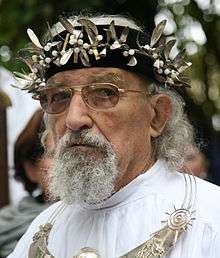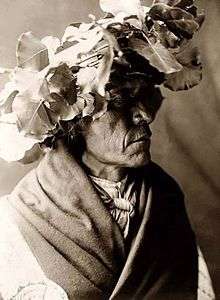Corolla (chaplet)

A corolla is an ancient headdress made of a garland or wreath and worn as a small circlet or crown. Usually it has ceremonial significance and represents victory or authority.
History
The term corolla and/or corollæ appears in a chapter title in Pliny the Elder's Naturalis Historia: "Who invented the art of making garlands: When they first received the name of 'corollæ,' and for what reason."[1]
The term was used to describe a crown made from branches and twigs of trees worn by victors in sacred contests. Later, flowers, colors and smells were used to "heighten the effect".[2]). Glyccra challenged Pausias to a contest where she would repeatedly vary her designs, and thus it was (as Pliny described it) "in reality a contest between art and Nature". This invention is traced only to later than the 100th Olympiad via Pausias paintings.[1]
These "chaplets of flowers" became fashionable and evolved into the Egyptian chaplets using ivy, narcissus, pomegranate blossoms. According to Pliny, P. Claudius Pulcher[3] introduced winter corollæ, made for the time at which flowers and plant matter are not available of thin laminæ of horn stained various colors.[1]
Slowly, the name was introduced at Rome, these garlands being known there at first as "corollæ" (the diminutive of corona), a name Pliny says was given them to express the "remarkable delicacy of their texture."
Later, these head dresses were made of thin plates of copper, gilt or silvered, and were called "corollaria",[1] as introduced by Crassus Dives as a way to confer a greater honor when receiving them.[3]
In Chapter 5 of Naturalis Historia, titled "The great honour in which chaplets were held by the ancients" Pliny explains the how these head dresses were perceived:
Chaplets, however, were always held in a high degree of estimation, those even which were acquired at the public games. For it was the usage of the citizens to go down in person to take part in the contests of the Circus, and to send their slaves and horses thither as well. Hence it is that we find it thus written in the laws of the Twelve Tables: "If any person has gained a chaplet himself, or by his money, let the same be given to him as the reward of his prowess." There is no doubt that by the words "gained by his money," the laws meant a chaplet which had been gained by his slaves or horses. Well then, what was the honour acquired thereby? It was the right secured by the victor, for himself and for his parents, after death, to be crowned without fail, while the body was laid out in the house, and on its being carried to the tomb.— [4]
Pliny continues the explanation to describe the severity in which the rules of the wearing of the chaplets were enforced by the "ancients":
- L. Fulvius, a banker, having been accused, at the time of the Second Punic War, of looking down from the balcony of his house upon the Forum, with a chaplet of roses upon his head, was imprisoned by order of the Senate, and was not liberated before the war was brought to a close.
- P. Munatius, having placed upon his head a chaplet of flowers taken from the statue of Marsyas, was condemned by the Triumviri to be put in chains. Upon his making appeal to the tribunes of the people, they refused to intercede in his behalf
- The daughter of the late Emperor Augustus, who, in her nocturnal debaucheries, placed a chaplet on the statue of Marsyas, conduct deeply deplored in the letters of that god.[5]
Emperor Augustus's daughter Julia placed a corolla on the head of a statue, and she was exiled for breaching morality laws.
Examples
See also
References
- 1 2 3 4 the elder, Pliny. "21.3". In John Bostock; Henry Thomas Riley. Naturalis Historia. Tufts University: Perseus Digital Library. Retrieved 2008-02-22.
- ↑ Flaccus, Quintus Horatius (Jun 27, 2006) [1854]. "Notes". In J. Bartlett. The Works of Horace (PDF). Original from Harvard University. p. 262. Retrieved 2008-02-22.
The poet, who thought that he had taken leave of love, confesses that he has yet again been captivated by Glyccra
- 1 2 the elder, Pliny. "21.4". In John Bostock, M.D., F.R.S., H.T. Riley, Esq., B.A.,. Naturalis Historia. Tufts University: Perseus Digital Library. Retrieved 2008-02-22.
- ↑ the elder, Pliny. "21.5". In John Bostock, M.D., F.R.S., H.T. Riley, Esq., B.A.,. Naturalis Historia. Tufts University: Perseus Digital Library. Retrieved 2008-02-22.
- ↑ the elder, Pliny. "21.6". In John Bostock, M.D., F.R.S., H.T. Riley, Esq., B.A.,. Naturalis Historia. Tufts University: Perseus Digital Library. Retrieved 2008-02-22.




_-_n._0269_-_Boy_with_laurel_wreath.jpg)




